Instructions for Side by Side Printing
- Print the notecards
- Fold each page in half along the solid vertical line
- Cut out the notecards by cutting along each horizontal dotted line
- Optional: Glue, tape or staple the ends of each notecard together
Lab Practical: (Chapter 9/10) The Skull: Cranial & Facial Bones
front 1 The frontal and maxillary sinuses, along with sinuses in the ethmoid and sphenoid bones, collectively form the paranasal sinuses. What painful condition results when the passages from these sinuses into the nasal cavity are blocked? | back 1 a sinus headache |
front 2 With what structure does the temporal process of the zygomatic bones articulate | back 2 the zygomatic process of the temporal bone |
front 3 What two pairs of bones make up the hard palate? | back 3 bones- the maxillae and palatine bones structures- the palatine process of the maxillae, and the horizontal plates of the palatine bones |
front 4 What is the collective function of the auditory ossicles? | back 4 to transmit vibrations (sound) from the eardrum to the inner ear |
front 5 What is the function of the hyoid bone? | back 5 The hyoid bones forms a base of attachment for the tongue. It also serves an attachments site for muscles involved in swallowing |
front 6 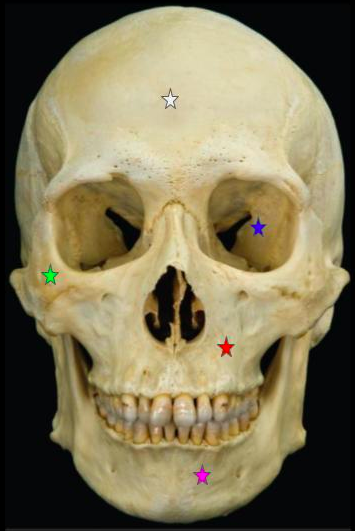 Identify the bone indicated by the white star. | back 6 frontal bone |
front 7  Identify the bone indicated by the green star. | back 7 zygomatic bone |
front 8  Identify the bone indicated by the blue star | back 8 sphenoid bone |
front 9  Identify the bone indicated by the red star | back 9 Maxillary bone |
front 10  Identify the bone indicated by the pink star. | back 10 mandible |
front 11 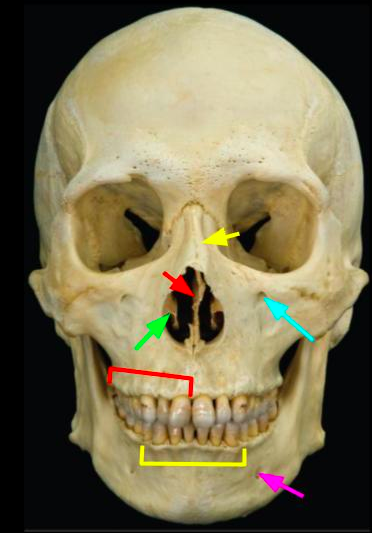 Identify the bone indicated by the yellow arrow. | back 11 nasal bone |
front 12  identify the structure indicated by the red arrow. | back 12 perpendicular plate of the ethmoid bone |
front 13  What articulates with the red arrow structure inferiorly? | back 13 vomer |
front 14  Identify the bone indicated by the green arrow. | back 14 inferior nasal concha |
front 15  What is the function of the bone indicated by the green arrow? | back 15 Increases surface area and air turbulence in the nasal cavity |
front 16  Identify the opening indicated by the blue arrow. | back 16 infraorbital foramen of the maxillary bone |
front 17  Identify the ridge indicated by the red bracket. | back 17 Alveolar process of the maxillary bone |
front 18  Identify the ridge indicated by the yellow bracket. | back 18 Alveolar process of the mandible |
front 19  What articulates with the red and yellow bracket structures? | back 19 Teeth |
front 20  Identify the opening indicated by the pink arrow. | back 20 mental foramen of the mandible |
front 21  What passes through the opening indicated by the pink arrow? | back 21 inferior alveolar nerve |
front 22 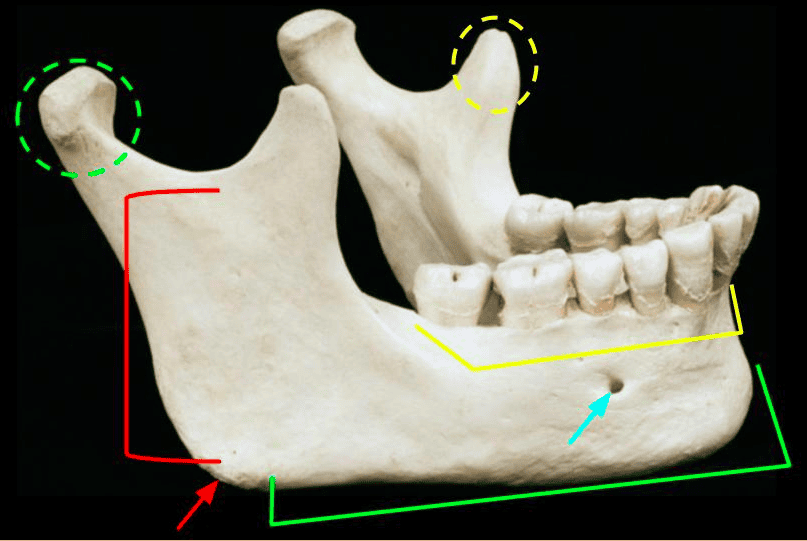 Identify the structure indicated by the green circle | back 22 condylar process of the mandible |
front 23  What articulates with the structure | back 23 mandibular fossa of the temporal bone |
front 24  Identify the structure indicated by the yellow circle. | back 24 coronoid process of the mandible |
front 25  What is the function of the structure indicated by the yellow circle | back 25 Attachment site for the temporalis muscle |
front 26  Identify the region indicated by the red bracket. | back 26 Ramus of the mandible |
front 27  Identify the region indicated by the green bracket. | back 27 Body of the mandible |
front 28  Identify the structure indicated by the red arrow. | back 28 Angle of the mandible |
front 29  Identify the ridge indicated by the yellow bracket. | back 29 Alveolar Process of the mandible |
front 30  What articulates with the structure indicated by the yellow bracket. | back 30 Teeth |
front 31  Identify the opening indicated by the blue arrow. | back 31 mental foramen of the mandible |
front 32  What passes through the opening indicated by the blue arrow? | back 32 inferior alveolar nerve |
front 33 Yellow Marrow is made of adipose tissue. What's its function? | back 33 yellow marrow in the bone is primarily for storage of energy |
front 34 Consider the following bones: femur, humerus, sternum, scapula, and rib. Which one of these bones contains compact bone? Which of these bones contain bone marrow | back 34 All of the bones in the body contains compact bone and bone marrow |
front 35 Consider the following bones: femur, humerus, sternum, scapula, and rib. Which of these bones contain bone marrow | back 35 All of the bones in the body contains compact bone and bone marrow |
front 36 What are the four sutures that involve the parietal bone? List four structures and for each one name the other bone involved in the articulation | back 36 Sagittal Suture: The other parietal bone Coronal Suture: frontal bone Lambdoidal Suture: occipital bone Squamous Suture: temporal bone |
front 37 In general terms, why is it important for at least some of the cranial bones to have holes? | back 37 Holes are necessary so that blood vessels and nerves may enter and exit the skull |
front 38 Where is the marrow if there is no marrow cavity? | back 38 The spongy bone |
front 39 What is the function of red marrow and where is it found? | back 39 Function: Formation of Blood Cells Found: heads of femur (thigh) humerus (upper arm) sternum coxal bone |
front 40 Which are the only bones that have medullary cavities? | back 40 Long Bones |
front 41 What are examples of flat bones? | back 41 ribs, scapula and sternum |
front 42 What are two things that make bones in your fingers and toes long bones? | back 42 1. They're shaped like rods with the length generally greater than the diameter 2. Inside each long bone is a hollow cavity called medullary cavity (only in long bones) |
front 43 Describe the Axial Skeleton? | back 43 the portion of the skeleton found in the longitudinal axis of the body it consists of 80 bones, including those of the skull, the vertebral column and the thoracic cage most are either flat or irregular bones |
front 44 Describe the Appendicular Skeleton | back 44 Includes 126 bones that make up the arms, legs, pectoral and pelvic girdles. (girdles attach the arms and legs to the axial skeleton) Most are either long or short bones |
front 45 What is diploë? | back 45 Diploë is the spongy bone in the flat bone |
front 46 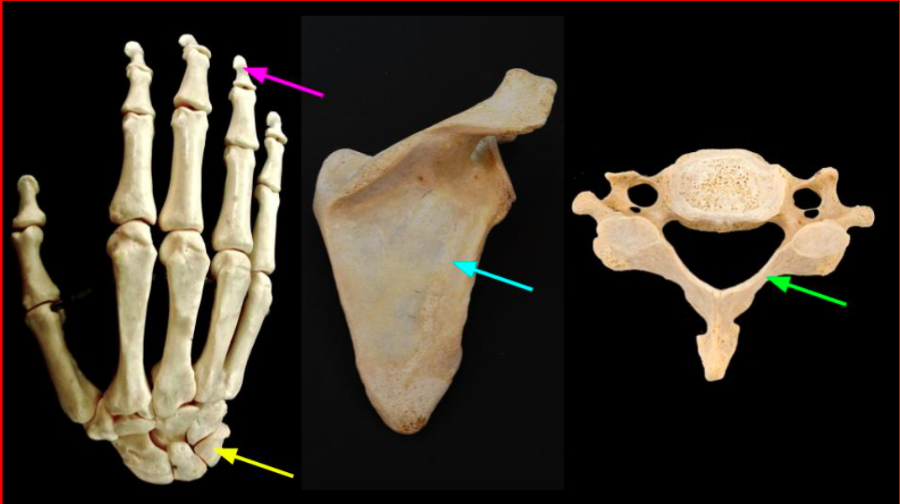 Identify the type of bone indicated by the yellow arrow. | back 46 short bone |
front 47  Identify the type of bone indicated by the pink arrow. | back 47 long bone |
front 48  Identify the type of bone indicated by the blue arrow. | back 48 flat bone |
front 49  Identify the type of bone indicated by the green arrow | back 49 irregular bone |
front 50 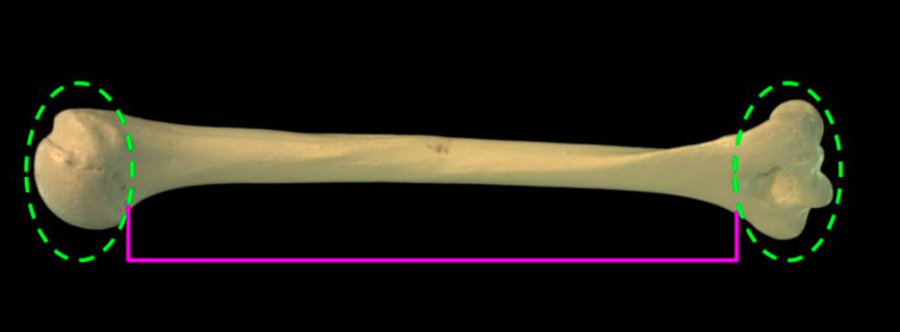 Identify the structural region indicated by the pink bracket. | back 50 diaphysis |
front 51  What membrane would surround the pink bracket region? | back 51 periosteum |
front 52  Identify the structural regions indicated by the green ovals. | back 52 epiphyses |
front 53  What would cover the joint surfaces in the green oval regions? | back 53 Hyaline (articular cartilage) |
front 54 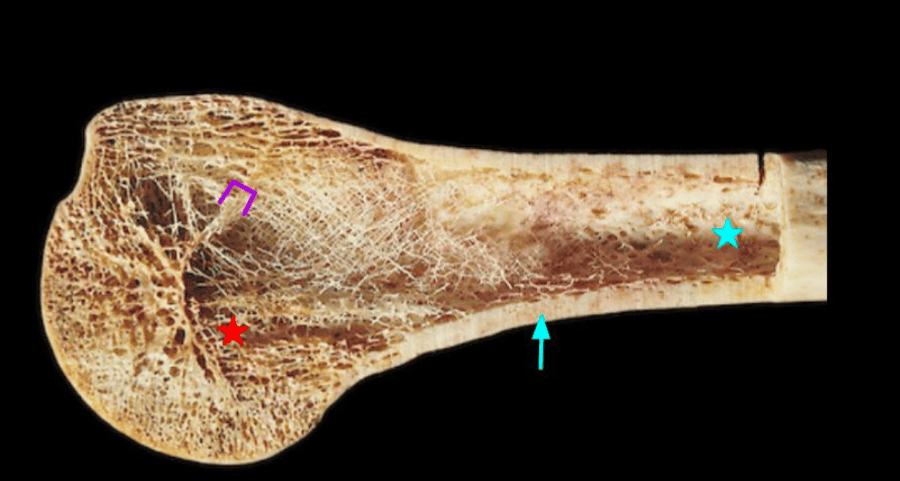 Identify the bone tissue indicated by the blue arrow. | back 54 compact bone |
front 55 Identify the structure indicated by the purple bracket. | back 55 epiphyseal line |
front 56 What was the purple bracket structure previously? | back 56 epiphyseal plate |
front 57 What type of bone is indicated by the red star? | back 57 spongy bone |
front 58 What space is indicated by the blue star? | back 58 medullary cavity |
front 59 What would be found within the space indicated by the blue star and what is its function? | back 59 yellow bone marrow (adipose tissue=energy storage) |